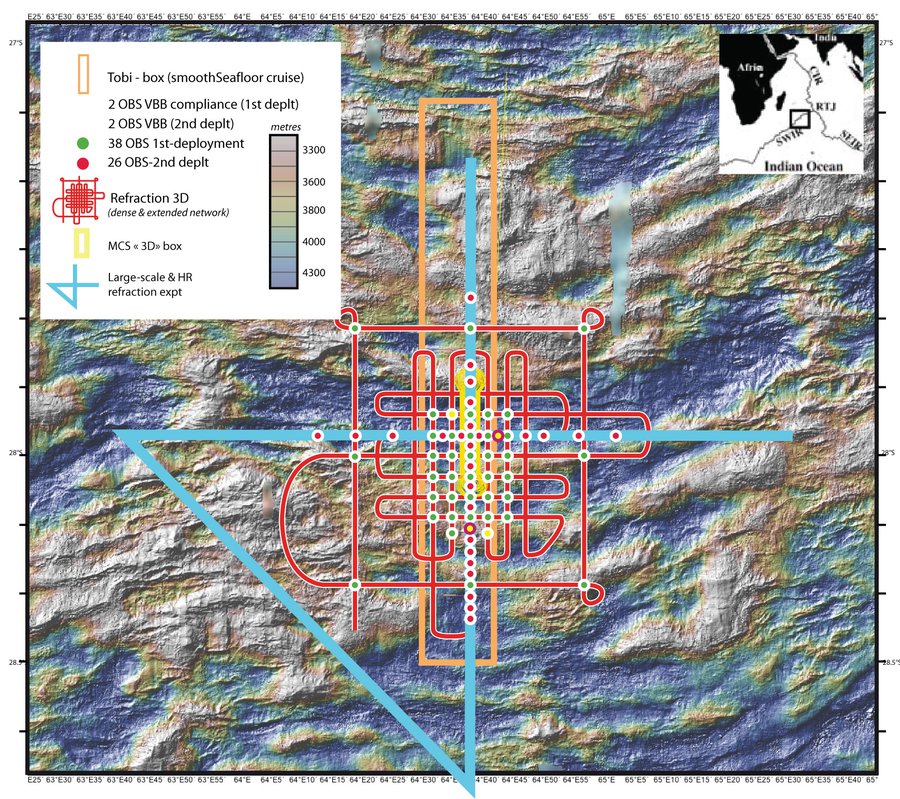SismoSmooth: 2D/3D MCS/OBS Characterization of Exhumed Ultramafic Seafloor at the Ultra-slow Spreading SW Indian Ridge
In collaboration with IPG Paris 5, ISTEP (UPMC) 3, and IPG Strasbourg
Funding by the Flotte Oceanographique Francaise of France and Natural Sciences and Engineering Research Council of Canada Shiptime fund
Exhumation of mantle derived rocks at the seafloor is common at slow spreading ridges and is inferred and observed (though only by deep-sea drilling on a few basement highs) at the distal parts of many divergent continental margins, at the ocean-continent transition (OCT). Mantle exhumation involves large normal fault displacements, changes lithospheric thermal conditions, and results in various magmatic and hydrothermal processes at the plate boundary. At rifted margins, these thermal conditions, prevailing during the final rifting stages, are of particular relevance to oil and gas exploration. In ridge and in OCT settings, mantle exhumation may also favour specific deep seafloor ecosystems (hydrogen and methane produced during serpentinization may be used as a fuel for microbial activity). A key question for fundamental science and petroleum exploration is how to predict the presence of exhumed mantle rocks underlying thick post-rift sedimentary sequences at OCTs. This presence is commonly inferred from seismic characteristics such as a high VP/VS ratio, or a low vertical velocity gradient. Investigating serpentinization at slow spreading mid-ocean ridges is much simpler. There, the sediments are thin or locally absent, serpentinized mantle rocks can be sampled at the seafloor, and detailed seismic imaging of crystalline rocks is far simpler than at the continental margins. This means that at slow spreading ridges fundamental questions concerning the depth- and volume-extent of serpentinization within the crystalline basement can be quantitatively answered with much greater accuracy then at OCTs.
We aim to address these questions by investigating an exceptional region of ultra-slow spreading mid-oceanic ridge system, the eastern part of the Southwest Indian Ridge (Figure 1), that has a very low magma supply and where ultramafics are exhumed over distances of up to 100 km or more along and across the ridge axis, with a very small proportion of magmatic intrusions. Our study area represents a worldwide end-member in terms of the ratio of tectonic to volcanic accretion at a ridge axis. Plate separation there is almost 100% due to faulting and exhumation. This region therefore provides a natural laboratory for evaluation of seismic characteristics of serpentinized mantle rocks and for establishing geophysical fingerprints of an exhumed serpentinized mantle domain. We have proposed conceptual models of axial fault evolution in this region, which stand the test of the available geological, sidescan sonar, gravity, and magnetic data. These models allow us to make predictions of the geometry of successive faults at depth, which we want to test using seismic data. A secondary objective is to investigate the modalities of mantle exhumation at diverging plate boundaries. While the importance of tectonically-dominated accretion (leading to exhumation of ultramafics and gabbros) at slow spreading ridges is now recognized, the dynamics of the large offset axial faults that accommodate this accretion are not yet well constrained. Questions that are raised concern: (a) factors that favour long-lasting activity of axial faults, which then develop into detachments; (b) conditions that promote the abandonment of a fault and the initiation of a new master fault; (c) conditions that cause axial master faults to flip polarity, allowing for deeply-derived ultramafic or gabbroic rocks to be exposed at both plates.

Figure 1. SismoSmooth campaign. See legend insert for explanation of individual components. Inset shows the location of the study area relative to Africa and India.
To test the presented hypotheses and answer posed questions, we carried out a 2D/3D MCS and OBS experiment and collected compliance data over the eastern part of the Southwest Indian Ridge (Figure 1). The experiment, completed during the Fall of 2014, used R/V Marion Dufresne, a 4.5 km long MCS streamer GENAVIR and 40 OBS instruments, 20 (including 2 BBOBS) from the INSU-IPGP pool of instruments and 20 from the Dal/GSC pool of instruments. Local seismicity was recorded during recovery and deployment of the instruments. The research team comprises investigators from 3 French and one Canadian labs. Together, we have a strong expertise on the tectonics and seismic structure of mid-ocean ridges and continental margins.
The results of this study will also be relevant for the investigation of OCTs where mantle exhumation has been interpreted to occur by asymmetric detachment faulting and where mantle-derived peridotites are inferred in the upper lithosphere. This in particular because an increasing interest by the hydrocarbon industry coupled with the development of improved seismic imaging methods now enables to demonstrate that exhumed mantle associated with hyper-extended crust might form more than 50% of the world’s deep margins (e.g. Iberia-Newfoundland margins, where mantle exhumation is best documented, but also the Central and South Atlantic, the S. Australian margins, the northern Red Sea and the eastern Gulf of Aden). We will try to image the faults associated with exhumation of the mantle-derived material at the ridge, and the distribution of extensively serpentinized domains in relation to these faults. Studies of these structures suggest that these faults are rooted at very shallow levels and are far more complex than the classical lithospheric scale detachment faults.